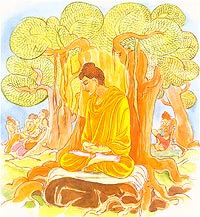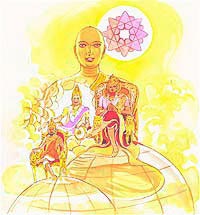27 05 2012 SUNDAY LESSON 621 FREE ONLINE eNālāndā Research And Practice UNIVERSITY And THE BUDDHISTONLINE GOOD NEWS LETTER by ABHIDHAMMA RAKKHITA through http://sarvajan.ambedkar.org
Dhammapada: Verses and Stories
Dhammapada
Verse 179
The Buddha Cannot Be Tempted

Verse 179.
The Buddha Cannot Be Tempted
That
Buddha traceless of infinite range
whose victory none may e’er undo,
whose vanquished follow to no world,
then by which track will you trace him?
Explanation:
The Buddha’s victory has not been won incorrectly. No one can turn Buddha’s
victory into defeat. Nothing that he has conquered can return, or pursue him,
because his conquest is so complete: His ken infinite, In what way can you
tempt or ensnare him.

Verse 180.
The Buddha Cannot Be Brought Under Sway
That
Buddha traceless of infinite range
in whom’s no entangling craving
and no ensnaring not anywhere lead,
then by which track will you trace him?
Explanation:
The Buddha, in whom there is no thirst (tanha) for grasping to the net that
lures, whose ken is infinite, in what way can you lure him away?
Dhammapada
Verses 179 and 180
Maradhitara Vatthu
Yassa
jitam navajiyati1
jitam yassa no’yati koci loke2
tam buddhamanantagocaram3
apadam4 kena padena nessatha.
Yassa
jalini visattika
tanha natthi kuhinci netave
tam buddhamanantagocaram
apadam kena padena nessatha5.
Verse
179: The Buddha, whose conquest (of moral defilements) is complete, in whom
there cannot arise any further defilements in this world, that Buddha of
infinite range of wisdom, who is trackless, - by what track will you lead him?
Verse
180: The Buddha, in whom there is no craving, which like a net would bring him
back to any existence (in samsara), that Buddha of infinite range of wisdom,
who is trackless, - by what track will you lead him?
1.
jitam navajiyati: ‘the conquest is complete’ means there is no need for further
conquests as there are no more moral defilements to be conquered.
2.
jitam yassa no’yati koci loke: lit., whose conquered defilements cannot be
followed by any further defilements in this world.
3.
anantagocaram: The range of wisdom of the Buddha is infinite by reason of his
omniscience, Sabbannuta nana. (The Commentary)
4.
apadam: lit., ‘trackless’. The Buddha, being free from conditions of rebirth,
such as craving, clinging, passion, etc., his track or passage through samsara
has come to an end. (The Com.)
[The
same idea is conveyed in verses 92 and 93 which express the idea that the
arahat passes away, leaving no more trace of existence than a bird leaves its
passage through the air.]
5.
kena padena nessatha: lit., by what track will you lead him? It means he cannot
be lured by any temptation whatsoever.
The
Story of the Three Daughters of Mara
The
Buddha first uttered Verses (179) and (180) of this book while residing near
the Bodhi tree, with reference to the three daughters of Mara. He repeated
these verses to the brahmin Magandiya while journeying through the Kuru
country.
Magandiya
the Brahmin and his wife lived in the kingdom of the Kurus with their daughter
Magandiya who was exceedingly beautiful. She was so beautiful that her father
rudely turned down all her suitors. One day, early in the morning, when the
Buddha surveyed the world, he found that time was ripe for the brahmin
Magandiya and his wife to attain Anagami Fruition. So, taking his bowl and the
robes, the Buddha set out for the place where the brahmin usually went to offer
fire sacrifice.
The
brahmin, seeing the Buddha, promptly decided that the Buddha was the very
person who was worthy of his daughter. He pleaded with the Buddha to wait there
and hurriedly went off to fetch his wife and daughter. The Buddha left his
footprint and went to another place, close at hand. When the brahmin and his
family came, they found only the footprint. Seeing the footprint, the wife of
the brahmin remarked that it was the footprint of one who was free from sensual
desires. Then, the brahmin saw the Buddha and he offered his daughter in
marriage to him.
The
Buddha did not accept nor did he refuse the offer, but first, he related to the
brahmin how the daughters of Mara tempted him soon after his attainment of
Buddhahood. To the beautiful Tanha, Arati and Raga, the daughters of Mara, the
Buddha had said, “It is no use tempting one who is free from craving,
clinging and passion, for he cannot be lured by any temptation
whatsoever.”
Then
the Buddha spoke in verse as follows:
|
Verse |
|
|
|
Verse |
Then,
the Buddha continued, “Brahmin Magandiya, even when I saw those peerless
daughters of Mara, I felt no sensual desire in me. After all, what is this body
of your daughter? It is full of urine and filth; I don’t like to touch it even
with my foot!” On hearing those words of the Buddha, both the brahmin
and his wife attained Anagami Fruition. Later, they joined the Order and
eventually both of them attained arahatship.
VOICE OF SARVAJAN
Press
release National Campaign for SC/ST Human Rights
SC/ST rights activists enraged at the
failure of Indian delegations to address questions raised at the UN today
Geneva, May 24, 2012 - Dalit rights
activists gathered in Geneva are disappointed at the Indian delegation’s
immediate response to the real challenges that SC/STs face, when India was
reviewed at the UN Universal Periodic Review of India on 24 May.
Activists comment that the delegation
failed to adequately address concerns about strengthening the Prevention of
Atrocities Act, bringing in anti-discrimination law, the socio- economic development
of Scheduled Castes (SC/STs) and Scheduled Tribes (Tribals), and caste and
gender intersectionality, among a number of other key concerns.
http://dharmafarer.org/wordpress/sutta-discovery
SUTTA DISCOVERY (SD)
THE LIVING WORD OF THE BUDDHA
[Buddhist Sutras in Singapore]
SUTTA TRANSLATION PROJECT (since 2002 – )
PRINTING THE SUTTAS
That the World May Hear the Buddha Word
Sutta Discovery Publication Project
The Most Detailed Sutta Translation
(1) Why a new translation?
All the available English translations of the Suttas are
either faulty and out of date (done about a hundred years ago) or restricted by
space (as a single-volume work and lacking notes). So they are useful almost
only to the specialists.
20
reasons for Sutta Discovery series
- It is a global resource for Buddhism scholars and Buddhist
students. - The SD series is based on themes to sustain an interesting
and connected reading. (SD 37 for example is based on Right Livelihood.) - Detailed notes on
difficult words, names, and doctrines; & bibliographies. - The Sutta’s peyyala (repetitive
cycles) (especially those on Dharma training) are translated in full,
for reflection by monastics and lay practitioners. - The works are paragraphed, subtitled and numbered in a
reader-friendly way for easy reading in a scribal tradition (opposite of oral
tradition). - A high standard of referencing and cross-references to other
Suttas, essays, journal articles, etc, that are helpful to specialists
and students, for discussion or self-study. - A broad-based translation that uses alternative translations, amplified translations,
and comparative studies with Sanskrit, Chinese and other texts where
necessary. - It includes a digest of the related and latest scholarly
researches and writings, summarized, explained and discussed. - They serve as comprehensive sources and resources for study
and teaching notes for Dharma teachers, researchers and students. - Easy-to-use handbook for monastics (especially forest monks)
and practitioners for Sutta readings (for recording on MP3 etc)
and for meditation. - Socially-engaged studies to inspire Buddhist social workers: it addresses
various social and historical issues affecting Buddhism and religion. - The SD texts are freely available online at our websites, http://dharmafarer.googlepages.com & http://dharmafarer.org, and also
separately on CDs & USB drives. They can be freely used as is. - The SD texts form the basis of an online Buddhist studies
course. - The SD notes and studies are the materials for other reference
projects such as Dictionary of the Buddha’s
Words, A Sutta Dictionary, A Dharma Dictionary, Numerical Dictionary of Dharma and Sutta Index. - The translated Suttas will be published separately according to
Nikaya, that is, The Long Texts, The
Middle-length Texts, The Connected Texts and the Numerical Texts. - The SD series is inspired by the Mere Buddhist vision,
simple Dharma-moved living that brings awakening in this life itself. - The SD series is the basis for Dharma-based reforms in
Buddhism today. - It is a historical and practical guide to early Buddhist
meditation. - A helpful introduction to the study of key Pali terms and
passages. - 20. An excellent and enduring gift of the Dharma to
others.
(2) A history of the Sutta Discovery
The Sutta Discovery (SD) series started with the NUS
Buddhist Society weekly Sutta Study Group (SSG) classes in February 2002 and
the Buddhist Fellowship in February 2003. A new volume of translations and
essays (A4 size, averaging 180 pages) is released every three months.
These new SD volumes appear once every 3 months. These
volumes are fully studied in the BF (every Tuesday, since 2003) and the TMC
(every Wednesday, since 2006). By December 2009, Piya has completed at least 32
volumes of the Sutta Discovery. By 2030, over 100 SD volumes have been
projected. This current series is registered as ISBN
978-981-08-xxxx-x.
Beginning 2010, the SD Publication Project plans to publish
SD vol 1 onwards in book form, hopefully releasing 1-3 volumes each year, depending on funds. You can help us print
the Suttas.
3 Projected costs of Printing the
Suttas
3.1 This pioneer effort will be a “LIMITED
EDITION” of 1500 copies of the Sutta Discovery series, but more may be printed
if we have sufficient funds and demand.
3.2 FREE COPIES will be distributed to
interested Sangha members, Buddhist centres, tertiary societies, libraries, and
students.
3.3 Part of the publication will be
available on the open market TO GENERATE FUNDS for printing other SD volumes
and related works, and for supporting Piya Tan’s Dharma work.
3.4 YOU CAN HELP in the following ways,
besides publicizing this project for us:
(1) READER:
Donation of $25.00 or more, entitled to a free copy.
(3) STEWARD:
Donation of $500.00 and above.
(4) FULL SPONSOR: Donation of $5000.00 (cost
of printing 1500 copies of each SD Volume and mailing charges).
Your continued donations keeps the Sutta Translation project & this website going.
KNOW DHARMA, MAKE DHARMA KNOWN.
.
Sutta
Discovery are available in two formats
CD version and quarterly ring-bound volumes. The Sutta
Discovery CD version available (with Pali fonts & SD pdf versions, plus
Piya’s current works).
Books and CDs/USB flash drives are available on a donation basis, to get your copies, please email: dharmafarer@gmail.com or call 82110879 (ask for Ratna Lim).
.
FEEDBACK
from Bhante Kaccayana (27 May 2008)
Metta Vihara Forest Monastery, Germany
Dear Piya Tan,
Thousand thanks for the two CD´s with your precious Sutta material, which
arrived two days back! I also downloaded some from the website you mentioned.
All that is very precious and most useful for our sutta study group over here.